Huawei P50 Pro review: Elegant hardware and great cameras, but no Google or 5G
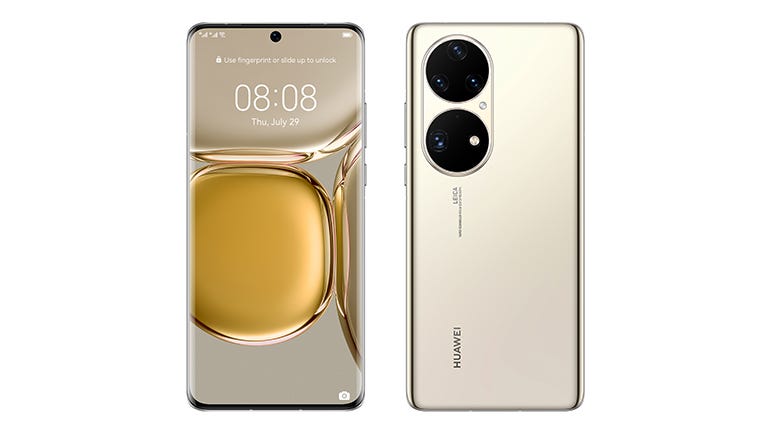
The 6.6-inch Huawei P50 Pro runs on Qualcomm’s Snapdragon 888 chipset with 8GB of RAM and 256GB of internal storage, but there’s no 5G support.
Images: Huawei
Huawei is marketing its P50 Pro flagship smartphone, which is now available outside China (but not in the US), as ‘a legend reborn’, but there are several complications to consider. Chief among these is the absence of Google Mobile Services, which, along with the lack of 5G support, substantially reduces its appeal. In fact, thanks to its well-publicised and ongoing problems with access to US technology, Huawei hasn’t figured in the worldwide top five smartphone vendors since Q3 2020, shortly before the company sold off its Honor sub-brand.
Huawei’s P-series phones have consistently offered excellent photography features, and the P50 Pro, which costs €1,199 in Europe (~$1,353), looks to continue that tradition. But is that enough?
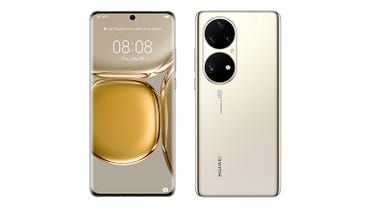
Like
- Excellent camera system
- Powerful chipset
- Premium design and build quality
- Fast charging (66W wired, 50W wireless)
Don’t Like
- No Google Mobile Services
- No 5G
Design
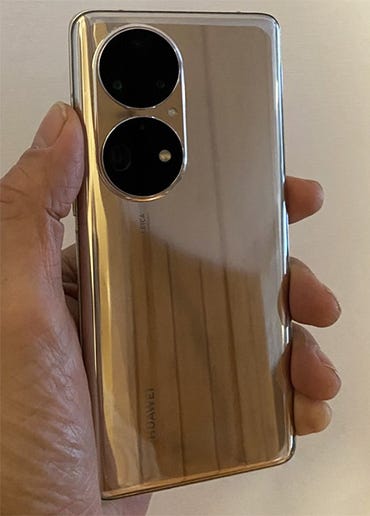
The P50 Pro’s Dual-Matrix camera system comprises wide-angle, ultra-wide angle and monochrome cameras in the upper ring and a periscope zoom camera in the lower ring.
Image: Charles McLellan / ZDNet
Huawei is known for its excellent industrial design and exemplary build quality, within the slab-of-glass smartphone paradigm. With the P50 Pro, the visual highlight is the large cartouche-shaped camera bump at the back, on the left-hand side, within which there are two large circular lens housings: the top one contains wide angle, ultra-wide angle and monochrome cameras, while the bottom one is home to a periscope telephoto camera (more on these below). Huawei calls this two-ring setup the Dual Matrix camera system (main camera matrix + super-zoom matrix).
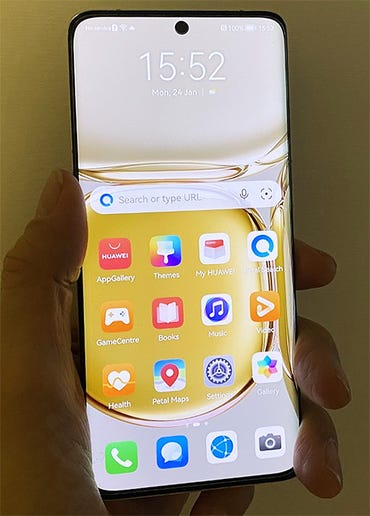
The 6.6-inch 120Hz OLED screen sits in slim bezels, resulting in a 91.5% screen-to-body ratio.
Image: Charles McLellan / ZDNet
The handset itself has a 6.6-inch OLED screen whose edges curve into the metal frame. The device measures 72.8mm wide by 158.8mm deep by 8.5mm thick (2.87in. x 6.25in. x 0.33in.) with narrow bezels and a front camera sitting in a central punch-hole, resulting in a screen-to-body ratio of 91.5%. The colour scheme for the (somewhat fingerprint-friendly) glass back of our review unit was Cocoa Gold; the alternative is Golden Black.
The P50 Pro weighs 195g, and even with the provided clear bumper case it’s comfortable to hold and navigate one-handed. Like most flagship-class handsets these days, this phone has an IP68 rating for dust and water resistance, which signifies that it’s ‘dust tight’ and can handle immersion in 1-3m of water for at least 30 minutes.
Features
The P50 Pro is powered by Qualcomm’s Snapdragon 888 chipset, and although this mobile platform normally supports 5G, it’s not implemented on this handset. The same goes for versions of the P50 Pro based on Huawei’s own Kirin 9000 chipset, which are available in China. This is all fallout from the US sanctions, which prevent Huawei from purchasing or manufacturing chipsets with 5G modems. If you buy this phone, you’ll have to be content with a 4G LTE connection or use Wi-Fi 6.
Our review handset had 8GB of RAM and 256GB of internal storage, of which 22GB was used for the OS and preinstalled apps out of the box, leaving 234GB free. Storage expansion is available via a proprietary Huawei Nano Memory (NM) slot, which is shared with the handset’s second SIM slot.
Huawei runs the Android-based EMUI 12 rather than Huawei’s HarmonyOS 2.0, although some functional elements of the latter are present. In fact, the distinction is somewhat academic since, on close inspection, HarmonyOS has been revealed as “essentially an Android fork”. On the P50 Pro, the Geekbench 5 app identifies the OS simply as ‘Android 11’.
The 6.6-inch OLED screen has a resolution of 1228 by 2700 pixels (20:9, 450ppi), a maximum refresh rate of 120Hz, a touch sampling rate of 300Hz, and supports 10-bit colour (1.07 billion colours). As you’d expect, the display is bright, vibrant and sharp.
You can set the screen resolution to Smart (dynamically adjusted), High (1228 x 2700) or Low (921 x 2025). There are also Dynamic, High (120Hz) and Standard (60Hz) settings for the refresh rate. If you need to eke out battery life, these settings, along with screen brightness, are the place to go. Other screen adjustments include dark mode, eye comfort (blue light and flicker reduction) and colour temperature (Normal or Vivid).
The handset can be unlocked using biometrics — in-screen fingerprint reader, face recognition — or by entering a PIN.
The top of the device has two mics, a speaker grille and an infrared sensor, while the bottom houses the (dual Nano) SIM tray, a mic, a USB-C port and a speaker grille. The left side is bare, while the right side carries the red-accented power button and a volume rocker. As noted, you can use the second SIM slot for a Huawei NM storage card if necessary. There’s no 3.5mm headphone jack.
User experience
EMUI 12 offers a clean user interface, with several enhancements for those who buy into the Huawei device ecosystem.
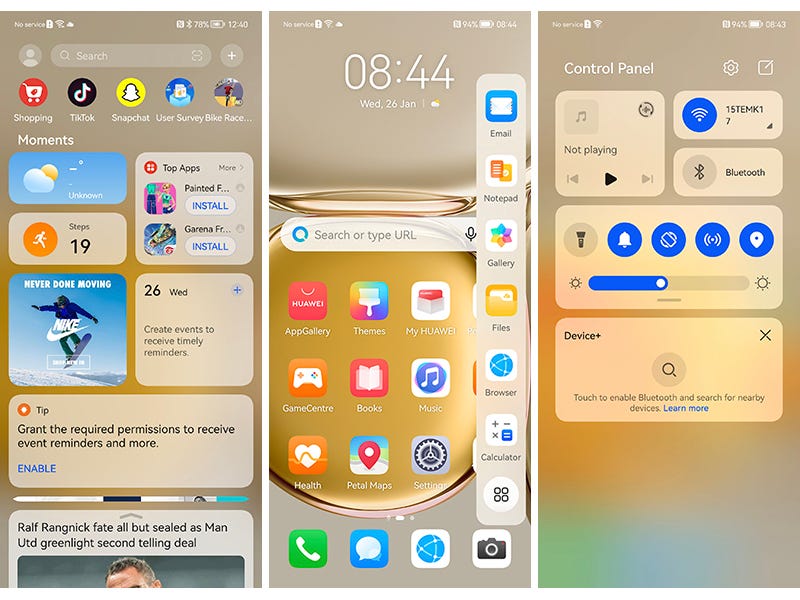
EMUI 12 on the P50 Pro.
Screenshots: Charles McLellan / ZDNet
There’s a new Control Panel, accessed by swiping down from the top right corner of the screen, which includes any ‘trusted’ Huawei devices that are signed into your Huawei ID. So long as wi-fi and Bluetooth are turned on, you can connect to these devices by tapping the icons in the Device+ tab.
We didn’t have any Device+-compatible kit, but we did have a Huawei MateView 28-inch monitor in for review, which supports wireless projection from the P50 Pro. You can enable this feature, which can either mirror the phone screen or simulate a desktop experience, either via Settings/More connections/Easy Projection, or simply by tapping the phone on the wireless icon on the monitor’s base.
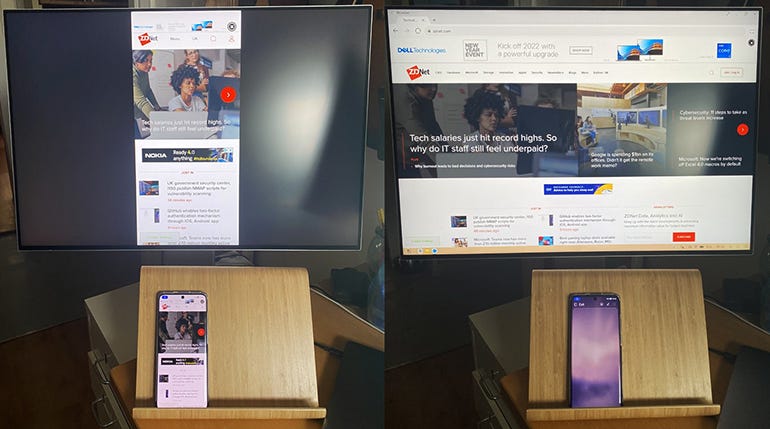
Wireless projection from the P50 Pro to Huawei’s MateView monitor: screen mirroring (left); simulated desktop, with the phone screen acting as a touchpad (right).
Images: Charles McLellan / ZDNet
The elephant in the room with recent Huawei phones like the P40 Pro, P40 Pro+ and Mate 40 Pro — outside China, at least — has been the lack of Google Mobile Services (GMS), which rules out the Play Store and any native apps, from Google or third parties, that use GMS integrations.
Huawei’s alternative to GMS and the Play Store is Huawei Mobile Services (HMS) and AppGallery. This is augmented by preinstalled Google replacements such as Petal Maps, and app search in Petal Search, which directs you to APKs direct from vendors or other sources such as APKPure. You can also transfer apps and data from an old phone using Phone Clone, although some apps may not work or receive updates in their new location.
Huawei has put a lot of effort into HMS and AppGallery since the US technology ban, and in December 2021 claimed 43.5 million active users in Europe (up 35% year on year), and 5.1 million registered developers worldwide.
Still, the process of assembling a collection of key apps does involve more hassle, and – as the song goes – you can’t always get what you want. I couldn’t find my bank’s app, for example, and the alternative – access via web browser – is a non-starter usability-wise, even on a 6.6-inch screen. Clock up too many similar examples in your list of must-have apps, and you’ll soon be looking elsewhere. That said, the Huawei experience will undoubtedly work for some.
Cameras
The P50 Pro’s distinctive Dual Matrix rear camera system, with two large rings housing the lenses and sensors, comprises four cameras: 50MP f/1.8 wide angle with OIS; 13MP f/2.2 ultra-wide angle; 64MP f/3.5 periscope telephoto with OIS and 3.5x optical zoom; and 40MP f/1.6 monochrome. The latter is a departure from the P40 series, which used a ToF (Time of Flight) sensor rather than a mono sensor to help with depth estimation for the bokeh effect. The mono camera also works with the main camera to add detail and reduce noise in low light conditions. There’s also a 13MP f/2.4 wide angle selfie camera in a central punch-hole at the top of the screen.
With the P50 Pro, Huawei brings one new technology, XD Optics, and an improvement over the P40 series in the shape of XD Fusion Pro. Huawei XD Optics applies image processing to rectify optical errors, boosting the image signal that’s passed to the computational photography algorithms by 25 percent, Huawei says. The XD Fusion Pro image engine includes a new Super Colour Filter System, a True Chroma Image Engine and Super HDR technology, resulting in improved detail, colours and dynamic range across the board.
Capabilities of the P50 Pro camera system include up to 100x zoom with improved image stabilisation, macro shots down to 2.5cm distance, 4K video capture with both front and rear cameras, and Dual View video recording with front and rear cameras at the same time.
Here’s a flavour of what the P50 Pro can do:

P50 Pro images at 1x zoom (top left), wide angle (top right), 10x zoom (bottom left) and 100x zoom (bottom right).
Images: Charles McLellan / ZDNet


P50 Pro images: monochrome (top left), 1x close up (top right), 1x and the same image cropped to show fine detail (bottom left & right).
Images: Charles McLellan / ZDNet

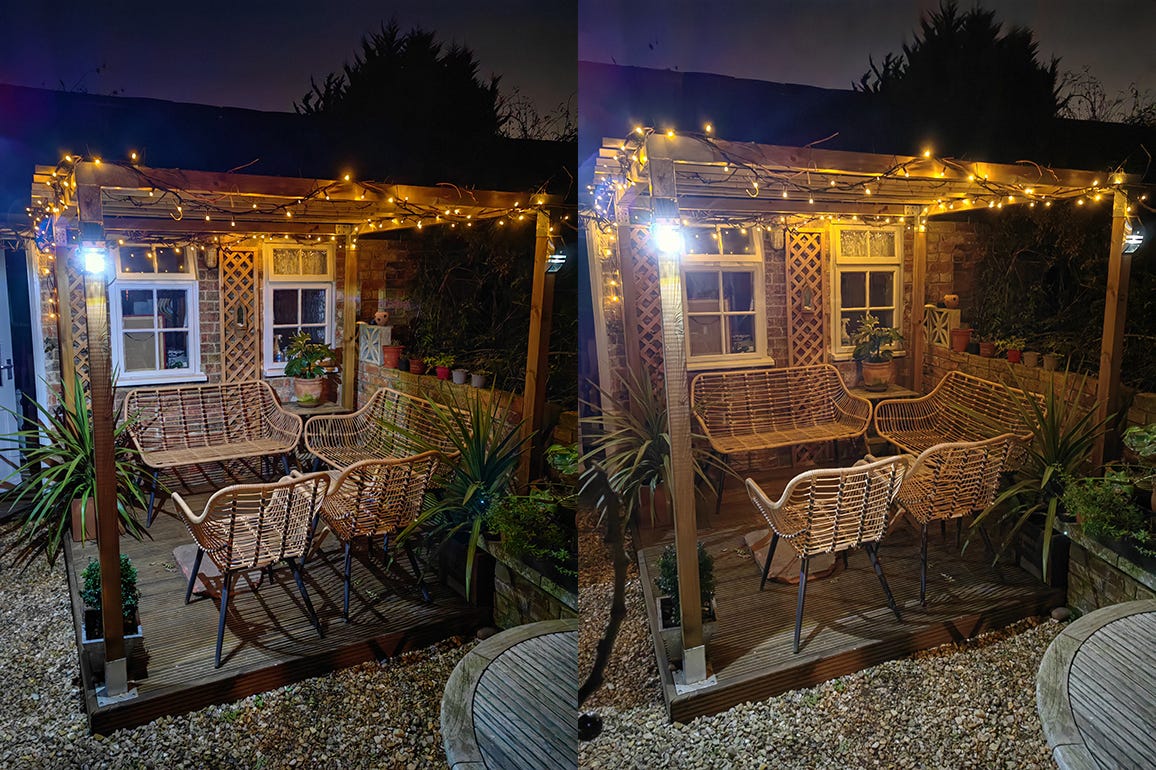
P50 Pro images: night mode (left), normal photo mode (right). Note the reduced yellow cast and more vibrant colours in the night-mode shot.
Images: Charles McLellan / ZDNet

In a relatively short test period, we found the P50 Pro’s advanced camera system both capable and rewarding to use. It’s no surprise to find that it currently heads up the smartphone camera rankings at DXOMARK, just ahead of the Xiaomi Mi Ultra 11.
Performance & battery life
The P50 Pro delivers performance in line with other flagship-class handsets based on Qualcomm’s Snapdragon 888 chipset, such as Samsung’s 6.7-inch Galaxy S21+ 5G.
The P50 Pro beats the Galaxy S21+ 5G on the Geekbench 5 multi core CPU test, but is slightly behind on the single core benchmark:
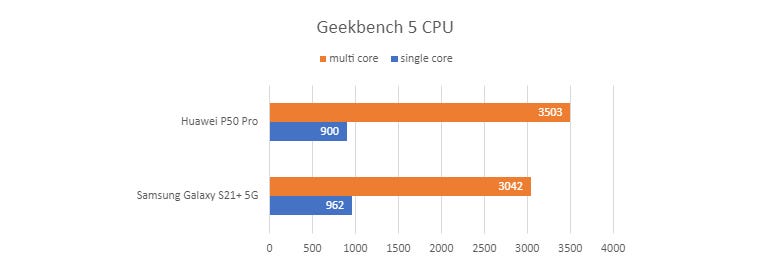
Image: ZDNet
GPU performance (Geekbench 5 Compute) is evenly matched, although the P50 Pro nudges slightly ahead on the both the Vulkan and OpenCL tests:
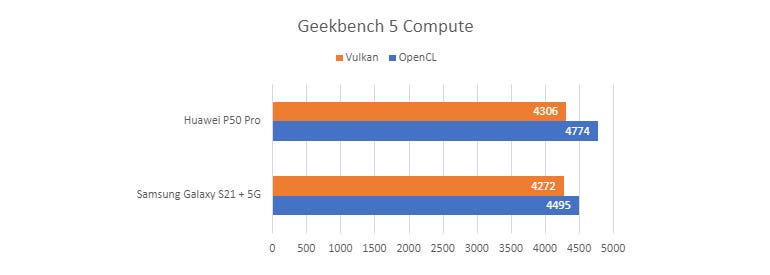
Image: ZDNet
The PCMark for Android Work 3.0 benchmark evaluates handsets on a range of everyday activities – web browsing, video editing, writing, photo editing and data manipulation. Both handsets perform well overall, but the Samsung Galaxy S21+ 5G comes out on top, with web browsing performance standing out at 1.9x that of the Huawei P50 Pro.
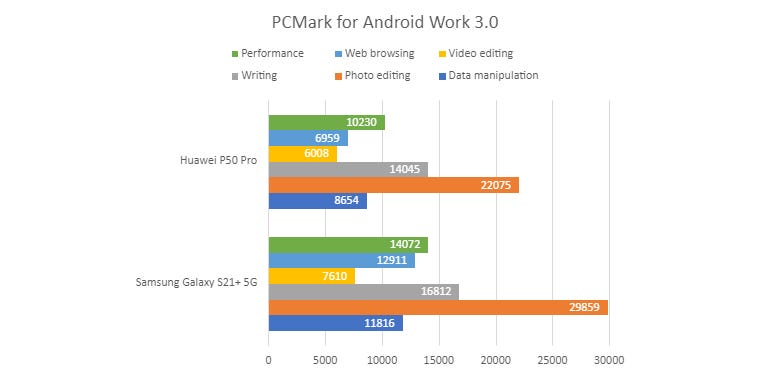
Image: ZDNet
The P50 Pro has a 4360mAh battery, which is an advance on the P40 Pro/+ (4200mAh) but less than the 5000mAh capacities seen on some recent flagship handsets. We tested battery life using the PCMark for Android Work 3.0 battery life benchmark, which drains the battery from 100% to 20% while continuously running the Work 3.0 test. The Huawei P50 Pro lasted for 11 hours 38 minutes, while the Samsung Galaxy S21+ 5G managed 12h 15m from its 4800mAh battery. You can compare more smartphone Work 3.0 battery life results here.
The Huawei P50 Pro supports 66W wired charging and 50W wireless charging, although you’ll need Huawei’s 66W SuperCharge charger and USB-C cable (supplied) and a 50W SuperCharge Wireless Charger Stand (a separate purchase) to achieve these power ratings.
Conclusions
We’ve given the Huawei P50 Pro an 8/10 (Excellent) rating: this would undoubtedly have been higher if Google Mobile Services and 5G were on-board. Although it’s a superbly designed flagship-class smartphone with an excellent camera system, many potential buyers won’t be able to ignore these two significant drawbacks, considering the four-figure price.
RECENT AND RELATED CONTENT
Huawei expands P50 Pro and P50 Pocket availability to more countries
Huawei P40 Pro+, hands on: A top-class flagship phone with super-zoom camera system, but no Google services
Huawei P40 Pro, hands on: Another superb Huawei phone, but still missing Google services
Huawei expects 2022 challenges amidst tech politics, deglobalisation
US President Biden signs law to ban Huawei and ZTE from receiving FCC licences
Best phone 2022: The top 10 smartphones available
Read more reviews







